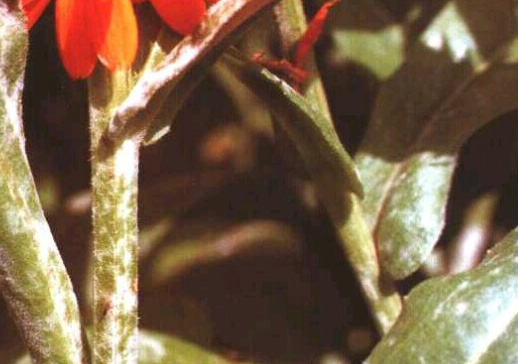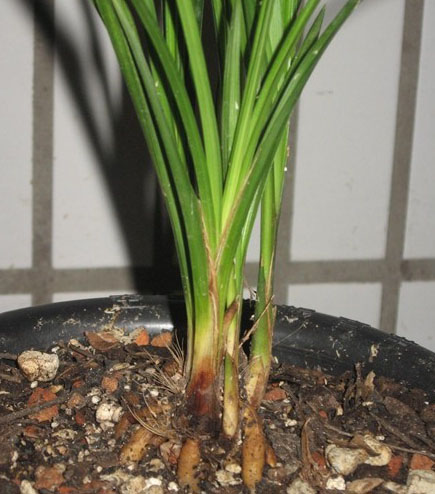Control methods of Alternaria leaf spot in cockscomb
Damaging plants: celosia cristata l.
Distribution and harm: the disease mainly occurs in Zhejiang, Yunnan and other places, the harm is serious.
Symptoms: there are round, oval, irregular dark brown spots on the front of the leaf. The initial spot is a small dot, the center is white, the outer ring is brown, 1 mm in diameter; in the later stage, the size of the spot is (5mm 18mm) x (5mm 8mm), the edge can be connected into a large spot, the edge is slightly raised, like a wheel, and the upper gray or black mildew layer.
Pathogen: the pathogen is Alternaria alternata. Conidia straight or branched, flexion, light brown, with 3 septum. The conidia are grenade-shaped, stick-shaped, pear-shaped, light brown or brown, with 1-6 transverse septum and 0-2 mediastinum, and the margin is long and light.
The regularity of the disease: the pathogen overwintered with mycelium in the disabled body. Conidia were produced in the early summer of the following year, and the disease was caused by wind and rain transmission and re-infection. The disease is easy to occur when the temperature is high and the humidity is high. The disease was serious in the lower leaves, and the seeds could adhere to spores.
Control methods: in the later stage of plant growth, diseased plants and diseased bodies should be removed in time, concentrated burning or deep burial. It is advisable to change new soil when potted. In the early stage of the disease, remove the diseased leaves, increase the application of potash fertilizer, less nitrogen fertilizer, pay attention to drainage, basin soil is not too wet. The seeds were mixed with 500% thiram wet powder before sowing. At the initial stage of the disease, spray 1500 times of 50% prohydantoin wettable powder, or 75% chlorothalonil wettable powder 600 times, or 40% Dafudan wettable powder 300 times 400 times.

Injury of cockscomb flower
Control methods of Alternaria leaf spot in cockscomb
First, harmful symptoms
The leaves are dark brown round to oval or irregular in shape, 1-10mm in size, slightly raised at the edge, grayish brown in the middle, with grayish black mildew, white in the center of the dots at first, brown in the outer circle, 1mm in size, and then melted to form 5mur18X 5Mel 8 (mm) large spots.
2. Morphological characteristics of pathogens
Alternaria celosiae Tassi is a half-known fungus; conidia club-shaped to pear-shaped, brown, with a longitudinal and diaphragm, light stalk and beak, the size of 17.5-75X6.3-10.5 (um).
Third, the characteristics of the disease
The mycelium and conidia on the diseased remains or the conidia of Alternaria alternata outside the diseased tissue, or adhered to the species surface, became the source of infection at the beginning of the next year. At room temperature, the conidia attached to the seed surface can survive for more than 1 year, the mycelium in the seed can survive for more than one and a half years, and the mycelium on the diseased residue can survive for 2 years indoors and more than 1 year in soil surface or moist soil. During the growing period, the conidia produced by the disease department were transmitted by wind and rain, and the conidia germinated and directly invaded the leaves. The condition was suitable for 3 days to show the disease, and soon formed conidia for re-infection. Seed carrier is an important way of long-distance transmission.
IV. Popular trends
The occurrence of the disease is closely related to the temperature and humidity during the growth period. The disease occurs when the temperature is 14 Mel 36 ℃ and the relative humidity is higher than 80%. There are many rainy days and heavy rainfall, and the relative humidity is higher than 90%. Sunny days and long sunshine have a certain inhibitory effect on the disease. Continuous cropping, partial application of nitrogen fertilizer, poor drainage and moisture retention are serious in production.
V. Prevention and control methods
(1) choose disease-free seeds.
(2) crop rotation.
(3) apply Baode biological fertilizer or compost made by enzyme bacteria retting or fully mature organic fertilizer to improve disease resistance. Strictly prevent flooding.
(4) the cockscomb maintained in greenhouse was treated with dust method or smoke method at the initial stage of the disease. ① dust method, spray 5% chlorothalonil dust in the evening, 1kg per 667m2. ② smoke method, ignite 45% chlorothalonil smoke remover in the evening, once every 7-9 days, and use it continuously or alternately depending on the condition.
(5) at the initial stage of the disease, 75% daconine wettable powder or 50% prohydantoin wettable powder, 80% Dasheng wettable powder and 80% spray gram wettable powder were sprayed in the early stage of the disease. Spraying medicine should be started before the onset of the disease. 60L of the right solution was sprayed per 667m2, once every 10 days, and prevention and treatment lasted for 3 times in a row. In case of rain 4 hours after spraying, make up spraying, spraying in time after rain in production can reduce the harm.
Control techniques of Alternaria leaf spot in cockscomb
Cockscomb is a common indoor ornamental flower, and its flowers are as beautiful as cockscomb. Celosia cristata gets its name because of its inflorescence red, flat and shaped like chicken crown, and enjoys the reputation of "bird in flowers". Celosia cristata is one of the famous open-field herbaceous flowers in the garden. The inflorescence is terminal, prominent, diverse in shape and color, bright and bright, has high ornamental value, and is also an important flower bed flower. Cockscomb is quite easy to raise plants, but in the process of breeding often appear Alternaria leaf spot phenomenon, which makes flower friends very distressed, the following editor to tell you about its prevention and control methods. 1. Symptoms: there are round, oval, irregular dark brown spots on the front of the leaf. The initial spot is a small dot, the center is white, the outer ring is brown, 1mm in diameter; in the later stage, the size of the spot is ((5~18mm) X (5~8mm)), the edge can be connected into a large spot, the edge is slightly raised, like a wheel, upper gray or black mildew layer. two。 Pathogen: the pathogen is Alternaria alternata. Conidia straight or branched, flexion, light brown, with 3 septum. The conidia are grenade-shaped, stick-shaped, pear-shaped, light brown or brown, with 1-6 transverse septum and 0-2 mediastinum, and the margin is long and light. 3. The regularity of the disease: the pathogen overwintered with mycelium in the disabled body. Conidia were produced in the early summer of the following year, and the disease was caused by wind and rain transmission and re-infection. The disease is easy to occur when the temperature is high and the humidity is high. The disease was serious in the lower leaves, and the seeds could adhere to spores. 4. Control methods: in the later stage of plant growth, diseased plants and diseased bodies should be removed in time, concentrated burning or deep burial. It is advisable to change new soil when potted. In the early stage of the disease, remove the diseased leaves, increase the application of potash fertilizer, less nitrogen fertilizer, pay attention to drainage, basin soil is not too wet. The seeds were mixed with 500% thiram wet powder before sowing. At the initial stage of the disease, spray 1500 times of 50% prohydantoin wettable powder, or 75% chlorothalonil wettable powder 600 times, or 40% Dafudan wettable powder 300 times 400 times.
- Prev

How to control powdery mildew of Calendula
Harmful plant: calendula (calendulaofeinalisl.). Distribution and damage: the disease is common in Hebei, Liaoning, Yunnan and other places, and the damage is serious. Symptoms: after the leaves and stems were infected, the leaves showed a powdery round spot of 0.5 mm to 1.2 mm.
- Next

Methods of preventing water rot of orchids
Around the Beginning of Summer is the peak period of orchid sprouting. During this period, the orchid seedlings are strong and grow fast. However, if we do not pay attention to reasonable watering and control of soil humidity, it is easy to make orchid seedlings get water rot, and even cause dead seedlings. The ways to prevent the disease are as follows: ① will plant orchids into steamed bread, that is, the soil barrier in the middle is high.
Related
- Fuxing push coffee new agricultural production and marketing class: lack of small-scale processing plants
- Jujube rice field leisure farm deep ploughing Yilan for five years to create a space for organic food and play
- Nongyu Farm-A trial of organic papaya for brave women with advanced technology
- Four points for attention in the prevention and control of diseases and insect pests of edible fungi
- How to add nutrient solution to Edible Fungi
- Is there any good way to control edible fungus mites?
- Open Inoculation Technology of Edible Fungi
- Is there any clever way to use fertilizer for edible fungus in winter?
- What agents are used to kill the pathogens of edible fungi in the mushroom shed?
- Rapid drying of Edible Fungi

